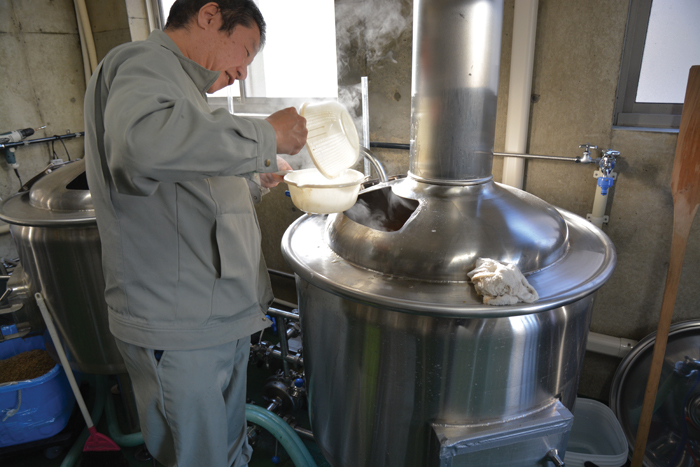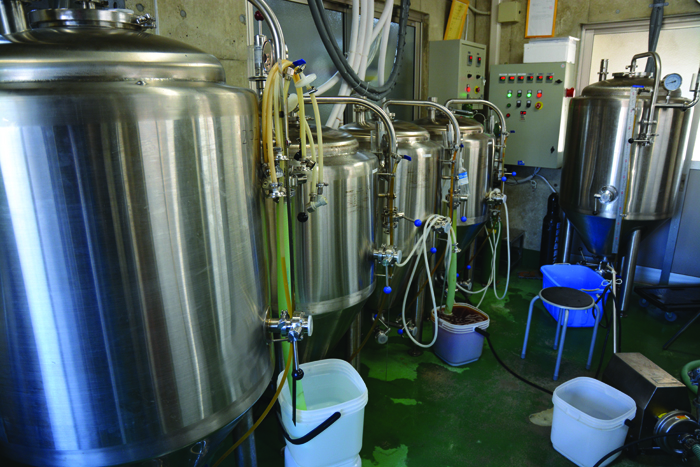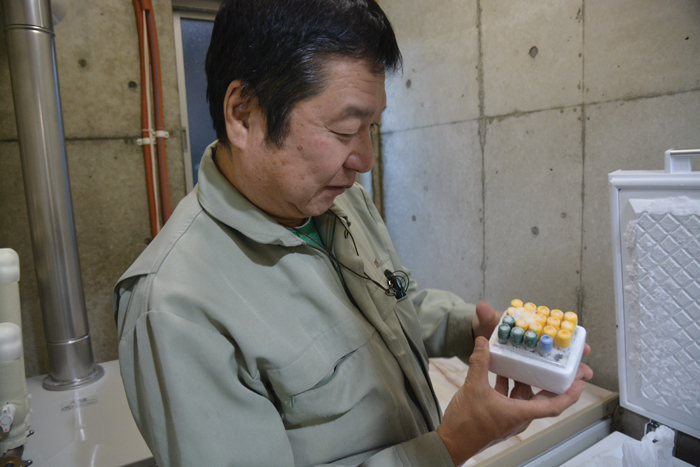Popeye in Ryogoku, Tokyo, opened in 1985 and in these past thirty years has become quite famous in Japan and beyond. The bar appears in various guidebooks on Japan and is certainly a Tokyo tourist spot in its own right. Popeye also launched brewing operations in 2014. The facility is located in Niigata’s Minami-Uonuma City, hometown of Popeye’s owner, Aoki Tatsuo.
The brewmaster is one Fujiki Tatsuo. There are probably a lot of people in the craft beer industry who have heard Fujiki’s name in conversation since the brewing laws changed in the mid-1990s. From 1990 to 1995, he brewed sake but took a job in 1996 with Yamato Brewery (now defunct) in Nara Prefecture to brew beer. Yamato Brewery produced a high quality brand called Waô that is remembered fondly by more than a few veteran drinkers. Popeye carried Waô beer back in the day and that’s how Aoki came to know about Fujiki.
Fujiki brewed at Hi-no-Tani Beer in Mie Prefecture for two years starting in 2001. During this period he worked with Kikuchi Akira, who is now the head brewer of Preston Ale (see Winter 2014 edition), in Tochigi Prefecture. After that two-year stint, he worked until 2012 at a sake brewery in Kyoto’s famed Fushimi district. During this extended period, he would also travel on the weekends to Hideji Beer (see Fall 2014 edition) in Miyazaki Prefecture to provide guidance on refining their beers.
Aoki, meanwhile, began cultivating hops in his hometown around 2009. He demurely notes that it was just to try it out, but it was probably for the purpose of personal beer study. Many readers have seen the hops; Aoki harvested them still on the vine and used them to decorate the interior of Popeye. Aoki then built a small cottage in Minami-Uonuma with architectural characteristics particular to the region. Because of the area’s heavy snow, the first floor merely features the garage and foyer, while the second is the primary living space.
When Aoki took a look at his finished garage, his first thought was, “Could I put a small brewery in here?” He rang up his old buddy Niwa Satoshi, the brewmaster at Outsider Brewing in Kofu City, Yamanashi Prefecture, for further counsel and determined that he could put one in for much cheaper than he had expected. Getting the brewery license took him just four or five months. You could say things were proceeding quite smoothly.
Aoki figured he would brew on his own in the beginning, but realized that for about half the week he needed to be in his bar. He wondered whom he could hire to brew for him and immediately thought of Fujiki. It wasn’t just that Fujiki had brewed delicious beer while at Yamato Brewery, but that he had repeated the feat at Hi-no-Tani. Aoki explains, “When Fujiki was at Hi-no-Tani, that marked the first time in Japan that a brewery had made real ale. Its wonderful flavor just coated your tongue.” Word is that Yo-Ho Brewing’s Yona Yona Real Ale was inspired by Fujiki’s real ale.
Aoki was determined to get Fujiki to return to the world of beer. When Aoki finally lured him back, Fujiki had to move from his urban comfort zone of Kansai for the first time since he had begun working. His new home was Japan’s famous snow country, an agricultural region known for its production of high-quality Koshihikari Rice. Fujiki’s face brightens and he laughs when reflecting on the abrupt change in environment, “The hardest part was that I couldn’t just go to my beloved theaters and watch movies anymore.” As Aoki jumped through the hoops to get the license, Fujiki brought with him some yeast propagation equipment in his possession.
Fujiki was now in charge of the brewery and for its name they decided on Strange Brewing, after the song “Strange Brew” by Cream, one of his favorite bands. When Aoki took a sip of Fujiki’s first batch, he was instantly pleased, “Wow, you’ve nailed this one.” This debut beer Aoki thought so delicious as to call a masterpiece was Golden Slumber (a pale ale by style, with the name deriving from a Beatles song). It went on tap at Popeye last June.
Aoki wasn’t just impressed by the final taste, but relates that he probably experienced true yeast aroma for the first time. People familiar with beer often describe as “yeasty” those beers that still smell of yeast from the fermentation. This beer, however, had none of that pungent rawness and instead smelled fresh and mellow. I even got a taste of some of that yeast during fermentation and indeed it lacked odor, with a quality more like slightly sugary flour. It is apparently protein-rich, almost like a nutrient supplement. “It did give off some hints of diacetyl, which is generally decried as an off-flavor,” says Aoki, “but the overall aroma was wonderful, with an alluring butterscotch quality.” Whether you call it “real yeast aroma” or “favorable diacetyl aroma”, part of this result owes to the decision to pitch fresh yeast with each batch.
Fujiki says, “The way that I handle yeast goes back to my experience in brewing sake.” Fujiki originally became enamored of aroma during the ginjo sake boom of the 1980s. Years later when he found employment at the sake producer despite his lack of experience, he eventually had a hand in the brewing process. The evaluation of sake aroma and flavor has influenced his tastes and also how he approaches beer.
He elaborates, “It would be irresponsible to the customer if the consistency of each batch were different and I was like, ‘the last batch wasn’t so good, but this time it’s delicious.’ In sake production, I didn’t reuse yeast and I follow the same practice with my beer.”
It’s like second nature to Fujiki to use fresh yeast with each batch and he cultivates a pure culture to enable this. This also ensures that he can reproduce the beer flavors he likes.
Aoki recalls, “Right after microbrewing became legal, places like Echigo Beer hosted ‘brewing workshops’ to support brewery openings from a technical standpoint. I’ve heard that they advised breweries on the importance of pure yeast cultures and their handling, but these days there doesn’t seem to be anyone providing any direction anymore. Even if you manage to get some fresh yeast, you need to know the technique for cultivating it to the point you can use it for fermentation.”
Fujiki seems to think that hops are more like a cosmetic. “A brewery’s primary job is to brew–in other words, to manage the fermentation process. Expressed in human terms, it’s to draw out somebody’s inner beauty. I think hops are kind of like a product that assists in enhancing that beauty.”
In addition to the Golden Slumber, I also had the pleasure of tasting his Big Head IPA, Honkey Tonk Imperial Stout and Love Potion #9 (a barley wine). All were marked by exceptional clarity (and mostly rock n’ roll related names). It would be no exaggerration to say that the impressive clarity coupled with malty goodness, fruity aroma, and hoppy bitterness is what makes the beers stand out. The Love Potion #9 weighs in at a whopping 10% alcohol and as you sip it down, it just seems to transform in mysterious ways, ultimately revealing itself to be quite a fantastic beer.
Popeye has always demonstrated keen inquisitiveness. That’s evident even from their beer serving system, which was born through careful consideration of how to best serve beer. Aoki got it patented. As many may already know, this beer server system is called the “Perfect Beer Server” and is in use at about 30 pubs across Japan. In Popeye’s ongoing quest to serve a pint of perfection, the bar’s drive to go above and beyond expectation is impressive. That same philosophy shows through in the beer. Even after thirty years, Aoki continues to push ahead.
Kumagai Jinya
This article was published in Japan Beer Times # () and is among the limited content available online. Order your copy through our online shop or download the digital version from the iTunes store to access the full contents of this issue.







